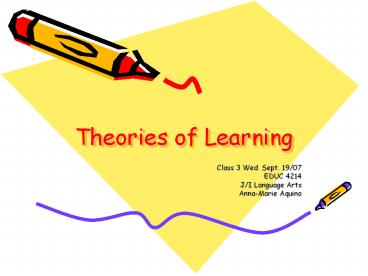Theories of Learning - PowerPoint PPT Presentation
1 / 24
Title:
Theories of Learning
Description:
Genre. Theme. Subject. Grade. Author. Title. Theories about Learning ... Musical/Rhythmic. The learner: *learns through rhythm, rhyme and repetition; ... – PowerPoint PPT presentation
Number of Views:292
Avg rating:3.0/5.0
Title: Theories of Learning
1
Theories of Learning
- Class 3 Wed. Sept. 19/07
- EDUC 4214
- J/I Language Arts
- Anna-Marie Aquino
2
Read Aloud
- The Report Card
- By Andrew Clements
- Jot Note grade, themes, subjects
3
Stories to Share with J/I Students
4
Theories about Learning
- Piagets Periods of Development
http//www.etr.org/recapp/theories/AdolescentDevel
opment/developmentalTheories.htm - Kohlbergs Stages of Moral Development
http//faculty.plts.edu/gpence/html/kohlberg.htm - Vygotskys Educational Theory http//www.newfounda
tions.com/GALLERY/Vygotsky.html - Scroll down to IVTheory of Learning
- Maslows Hierarchy of Needs http//en.wikipedia.or
g/wiki/Maslow's_hierarchy_of_needs - Eriksons Psychosocial Stages http//www.etr.org/r
ecapp/theories/AdolescentDevelopment/developmental
Theories.htm - Transformative Learning (http//members.iinet.net.
au/rstack1/transformative.htm)
5
Theories
- Organize yourselves into 6 groups
- Task each group will be responsible for
researching a particular theorist and prepare an
outline to share with the rest of the class. The
outline will be put on chart paper and posted at
the front of the classroom. You will have 30
minutes to prepare and 5 minutes to share the
information with the class. - Group 1 Piagets Periods of Development
- Group 2 Kohlbergs Stages of Moral Development
- Group 3 Vygotskys Educational Theory
- Group 4 Maslows Hierarchy of Needs
- Group 5 Eriksons Psychosocial Stages
- Group 6 Transformative Learning
6
Knowing Ourselves as Learners
Who am I?
What am I good at?
7
Multiple Intelligences
Different ways to demonstrate intellectual abilit
y
8
Verbal Linguistic
- The learner
- is sensitive to the sounds and meaning of
words - uses language for a variety of purposes
- responds to oral language
- enjoys reading.
9
Logical/Mathematical
- The learner
- recognizes abstract patterns and sees
relationships - reasons logically
- hypothesizes
- investigates issues scientifically.
10
Musical/Rhythmic
The learner learns through rhythm, rhyme and
repetition makes personal connections to sounds
in the environment responds to auditory stimuli
using rhythm, melody, patterned sound, song, rap
and dance.
11
Bodily/Kinesthetic
The learner is active and energetic learns
best by doing processes information through
touch, movement and dramatics.
12
Visual/Spatial Intelligence
The learner needs to see in order to
understand uses visual clues to make
meaning communicates ideas with images, mind
mapping, visualizing and drawing.
13
Interpersonal
The learner is people oriented and
outgoing learns best cooperatively demonstrate
s confident and appropriate social skills.
14
Intrapersonal
- The learner
- understands self as a learner
- is self-directed
- reflects on and analyzes personal learning
- can be reserved.
15
Naturalist
- The learner
- Relates to and is curious about nature
- Notices patterns in the environment
- Has extensive knowledge of the living world and
- Spends time outdoors.
16
How Am I Smart?
- Take a few moments to complete the Multiple
Intelligences Survey.
17
Reflect with a Partner
- Are the results what you would have predicted?
- How might these results influence the
instructional approaches you use in your
classroom? - Share with a partner
18
Multiple Ways of Knowing
- If we provide students with the opportunity to
develop the full range of their intellectual
capacities and teach them how to use their
multiple ways of knowing in the learning task,
they will learn the things we are trying to teach
more thoroughly than if we only permit them to
learn in the more traditional verbal linguistic
and logical mathematical ways. - David Lazear, 1989
19
Putting it All Together
- Characteristics of the junior/intermediate
learner - Theories of learning
- Multiple intelligences
- Understanding of how
- students learn
20
So What?
- Think/Pair/Share
- Reflect on the development of junior/intermediate
children and what that means for the classroom
(think about both the theories of learning as
well as the physical, emotional, intellectual and
social development from last class). - Share your thoughts with a partner.
21
Implications for the Classroom(adapted from
Teaching and Learning in the Junior Division,
North York Board of Education)
- Junior/Intermediate students need
- a stimulating, secure environment that encourages
risk taking, exploration and investigation - choices within guidelines
- experience day to day problem solving situations
- participate in organizing the classroom
22
- opportunities to work in small groups
- opportunities to explore individual interests
- opportunities to regularly monitor and evaluate
their own work - use concrete material
- Junior/Intermediate students need to be actively
involved in their own learning.
23
- Model Read Aloud/Teaching Strategy
24
- Sign up for Read Aloud and Strategy
- No reading
- Four Corners
- Literacy Stories Next Class































